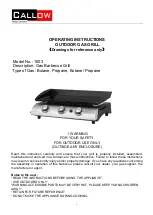
27
LAVA STONE GRILL - EASY 700
Maintenance information
UM300010
- 10/2019
©
Copyright 2019
5
5.3.1 Products that must not be used on stainless steel
- Never use chlorinated products, for example bleach, hydrochloric acid or any other solutions deriving
from the same. These products quickly attack stainless steel, causing irreversible corrosion.
-
To clean the floors underneath and near the appliances, never use the products mentioned above, since
vapours or drops that may fall on the steel produce similar corrosive effects to those described above.
- Never use iron scouring pads or leave them on the surfaces, since small deposits may remain on it and
lead to the formation of rust; use a soft stainless steel wool or synthetic fibre abrasive felt pads, always
wiping in the direction of the satin finish and taking care not to scratch the surfaces, then rinse and dry.
Fig. 5 Steel scouring pad
Fig. 6 Abrasive sponge
Fig. 7 Acidic substances
5.3.2 Some useful tips
- The pipes that supply water for use in pots, sinks, kitchens, washing machines, etc. inevitably surrender
some rust, especially when taps are turned on after a period of inactivity or in case of new systems. Take
care to prevent these oxides or ferrous deposits from coming into contact with the stainless steel for a
long period of time, since they produce corrosion. It is always advisable to use galvanized pipes and to
let the water run until it is perfectly clean.
- Avoid letting saline solutions evaporate, dry or stay in contact with stainless steel surfaces. For pots,
never use coarse kitchen salt, which stays on the bottom and due to its weight cannot circulate and
dissolve completely; this undissolved salt can cause corrosion. Therefore, it is advisable to crush it and
add it to the pots when the water is boiling; if this is not possible and the salt is coarse, dissolve it in a
separate container first. Avoid putting salt in pots of cold water or without water.
- When pots, washing machine compartments, bain-marie recipients, sinks, etc. are not used, they should
preferably remain uncovered in order to keep the passivation film protecting the stainless steel stable
and prevent it from coming into contact with possible aggressive agents.
















































